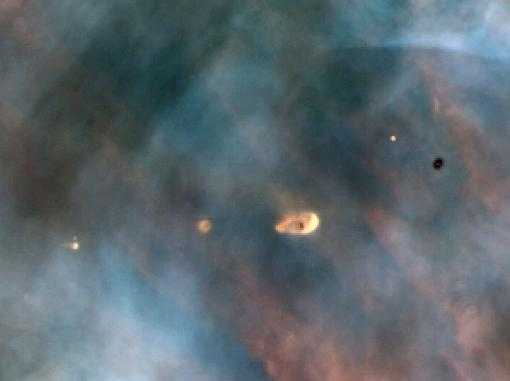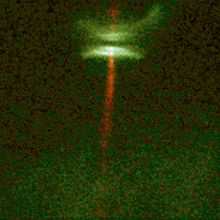Protoplanetary disk




A protoplanetary disk is a rotating circumstellar disk of dense gas surrounding a young newly formed star, a T Tauri star, or Herbig Ae/Be star. The protoplanetary disk may be considered an accretion disc because gaseous material may be falling from the inner edge of the disk onto the surface of the star, but this process should not be confused with the accretion process thought to build up the planets themselves. Externally illuminated photo-evaporating protoplanetary disks are called proplyds.
Formation
Protoplanetary disks around T Tauri stars differ from the disks surrounding the primary components of close binary systems with respect to their size and temperature. Protoplanetary disks have radii up to 1000 AU, and only their innermost parts reach temperatures above 1000 K. They are very often accompanied by jets.
Protostars typically form from molecular clouds consisting primarily of molecular hydrogen. When a portion of a molecular cloud reaches a critical size, mass, or density, it begins to collapse under its own gravity. As this collapsing cloud, called a solar nebula, becomes denser, random gas motions originally present in the cloud average out in favor of the direction of the nebula's net angular momentum. Conservation of angular momentum causes the rotation to increase as the nebula radius decreases. This rotation causes the cloud to flatten out—much like forming a flat pizza out of dough—and take the form of a disk. The initial collapse takes about 100,000 years. After that time the star reaches a surface temperature similar to that of a main sequence star of the same mass and becomes visible. It is now a T Tauri star. Accretion of gas onto the star continues for another 10 million years,[2] before the disk disappears, perhaps being blown away by the young star's solar wind, or perhaps simply ceasing to emit radiation after accretion has ended. The oldest protoplanetary disk yet discovered is 25 million years old.[3][4]
The nebular hypothesis of solar system formation describes how protoplanetary disks are thought to evolve into planetary systems. Electrostatic and gravitational interactions may cause the dust and ice grains in the disk to accrete into planetesimals. This process competes against the stellar wind, which drives the gas out of the system, and gravity (accretion), which pulls material into the central T Tauri star.
Protoplanetary disks have been observed around several young stars in our galaxy. Recent observations by the Hubble Space Telescope have shown proplyds and planetary disks to be forming within the Orion Nebula.
Gas-poor disks of circumstellar dust have been found around many nearby stars—most of which have ages in the range of ~10 million years (e.g. Beta Pictoris, 51 Ophiuchi) to billions of years (e.g. Tau Ceti). These systems are usually referred to as "debris disks". Given the older ages of these stars, and the short lifetimes of micrometer-sized dust grains around stars due to Poynting Robertson drag, collisions, and radiation pressure (typically hundreds to thousands of years), it is thought that this dust is from the collisions of planetesimals (e.g. asteroids, comets). Hence the debris disks around these examples (e.g. Vega, Alphecca, Fomalhaut, etc.) are probably not truly "protoplanetary", but represent a later stage of disk evolution where extrasolar analogs of the asteroid belt and Kuiper Belt are home to dust-generating collisions between planetesimals.
Some of the moons of Jupiter, Saturn, and other planets are believed to have formed from smaller, circumplanetary analogs of the protoplanetary disks. The formation of planets and moons in geometrically thin[citation needed], gas- and dust-rich disks is the reason the planets are arranged in an ecliptic plane. Tens of millions of years after the formation of the Solar System, the inner few AU of the Solar System likely contained dozens of moon- and Mars-sized bodies that were accreting and consolidating into the terrestrial planets that we now see. The Earth's moon likely formed after a Mars-sized protoplanet obliquely impacted the proto-Earth ~30 million years after the formation of the Solar System.
Relation to abiogenesis
Based on recent computer model studies, the complex organic molecules necessary for life may have formed in the protoplanetary disk of dust grains surrounding the Sun before the formation of the Earth.[5] According to the computer studies, this same process may also occur around other stars that acquire planets.[5] (Also see Extraterrestrial organic molecules).
See also
| Wikimedia Commons has media related to Proplyds in the Orion Nebula. |
- Planetary formation
- Formation and evolution of the Solar System
- Herbig–Haro object
- Debris disk
References
- ↑ Mamajek, E.E.; Usuda, Tomonori; Tamura, Motohide; Ishii, Miki (2009). "Initial Conditions of Planet Formation: Lifetimes of Primordial Disks". AIP Conference Proceedings 1158: 3–10. arXiv:0906.5011. Bibcode:2009AIPC.1158....3M. doi:10.1063/1.3215910.
- ↑ Mamajek, E.E., Meyer, M.R., Hinz, P.M., Hoffmann, W.F., Cohen, M., & Hora, J.L. (2004). "Constraining the Lifetime of Circumstellar Disks in the Terrestrial Planet Zone: A Mid-Infrared Survey of the 30 Myr old Tucana-Horologium Association". The Astrophysical Journal 612 (1): 496–510. arXiv:astro-ph/0405271. Bibcode:2004ApJ...612..496M. doi:10.1086/422550.
- ↑ White, R.J. & Hillenbrand, L.A. (2005). "A Long-lived Accretion Disk around a Lithium-depleted Binary T Tauri Star". The Astrophysical Journal 621 (1): L65–L68. arXiv:astro-ph/0501307. Bibcode:2005ApJ...621L..65W. doi:10.1086/428752.
- ↑ Cain, Fraser; Hartmann, Lee (3 August 2005). "Planetary Disk That Refuses to Grow Up (Interview with Lee Hartmann about the discovery).". Universe Today. Retrieved June 2013.
- ↑ 5.0 5.1 Moskowitz, Clara (29 March 2012). "Life's Building Blocks May Have Formed in Dust Around Young Sun". Space.com. Retrieved 30 March 2012.
- Davis, Sanford S. (2006). "A New Model for Water Vapor and Ice Abundance in a Protoplanetary Nebula". American Astronomical Society, DPS meeting #38, #66.07 38: 617. Bibcode:2006DPS....38.6607D.
- Kalas, Paul; J. Graham & M. Clampin (2005). "A planetary system as the origin of structure in Fomalhaut's dust belt". Nature 435 (7045): 1067–70. arXiv:astro-ph/0506574. Bibcode:2005Natur.435.1067K. doi:10.1038/nature03601. PMID 15973402.
Further reading
- Williams, J. P.; Cieza, L. A. (2011). "Protoplanetary Disks and Their Evolution". Annual Review of Astronomy and Astrophysics 49: 67. arXiv:1103.0556. Bibcode:2011ARA&A..49...67W. doi:10.1146/annurev-astro-081710-102548.
- Armitage, P. J. (2011). "Dynamics of Protoplanetary Disks". Annual Review of Astronomy and Astrophysics 49: 195–236. arXiv:1011.1496. Bibcode:2011ARA&A..49..195A. doi:10.1146/annurev-astro-081710-102521.